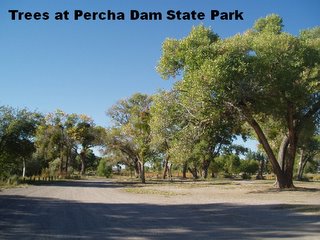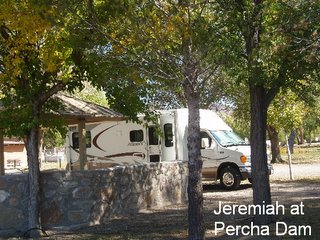Sandhill Cranes - and an unplanned move


Wednesday (October 26, 2005)
My life is like an orchestra. I am the conductor,
directing the many facets in order to make my own music.
Today's "music" started at 5 a.m. I had slept well, but didn't want to get up because it was cold - 54 degrees inside the motorhome. I turned on the heater and the coffee pot and climbed back in bed. In a few minutes the coffee was ready and Jeremiah was toasty warm.
It was pitch black outside, but started getting light about 7 a.m. I bundled up and went out for an early morning walk. As soon as I stepped out the door, I could hear birds overhead. At first I thought they were Canadian geese heading south, but later learned that they were sandhill cranes. They flew from north to south in sort-of "V-shaped" groupings of 50 or so, squawking loudly as they went. I counted 15 groups in just 10 minutes, and this continued for about 30 minutes. That's a lot of birds! These cranes spend the night on the sand dunes north of Caballo Lake, fly south to fields for feeding, then fly back in the afternoon.
As the sun came up over the mountains, I walked throughout the park enjoying the beauty and appreciating that I was there to see it. The river is very low, and it would be possible to rock-hop across in places. It's a huge difference from the full and fast-running river when I was here in the spring. A retired couple from nearby Truth or Consequences was fishing in one of the deeper spots.
After lunch I unloaded my bicycle and rode about three miles to Caballo's Visitor Center. While talking to a park ranger, I asked about Percha Dam Recreation Area (another section of Caballo). He raved about the beauty - the cottonwood trees taking on their fall color, the sandhill cranes and ducks feeding nearby, wildlife, including squirrels, rabbits, coyotes, foxes, raccoons and mule deer, roaming the park. Interested, I encouraged him to elaborate. Then he said that the park is very quiet because not many RVers want to traverse the mile-and-half washboard-rutted gravel road to get there.
He said that Percha Dam Park, established in 1970, is one of New Mexico's smallest parks. Its low dam was built in 1917 to provide irrigation water for local farms (they grow a lot of chile and alfalfa). This park is less crowded - mostly empty on weekdays - making it great for bird watching.
Since the park was only a few miles away, I biked over to check it out. The bumpy gravel road runs between two fields, one with silage and the other with alfalfa. The actual park entry drive goes over a rickety, one-lane wooden bridge.
It was "love at first sight!" It is spacious with grassy areas and hundreds of tall trees, including cottonwoods, Russian olives, green ash, and salt cedars. (see photo) This riparian area seems somewhat out of place in the southern New Mexico desert. There are 30 spacious electric/water RV sites (only one was occupied), and a huge area for tents, campers and picnics. The river is a stone's throw away. Reportedly it is good fishing for walleye, white bass and catfish. However, with the river so low, (see photo) I doubt that fishing is good now.
After checking with Bob and Joyce, the campground hosts, about moving from Riverside, they said, "No problem. Come on ahead, and choose any of the sites you want." I hopped on my bike and high-tailed it back to Jeremiah. I quickly got unhooked and ready for the short trip.
I chose site #2 because it was shaded from the afternoon sun, had a picnic table/cabana alongside, and wasn't too far from the restroom/shower. (see photo) I was hooked up in no time, getting four mosquito bites in the process. When I settled in for the night, I reflected on another good day, eager to explore this park in the morning. As my coffee mug says:
"Adventure is worthwhile in itself!"

<< Home